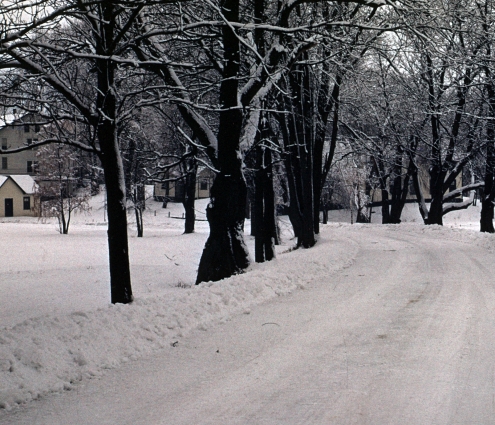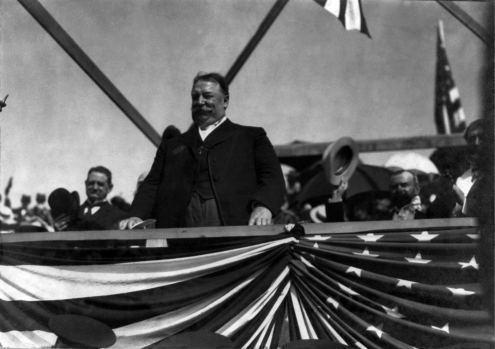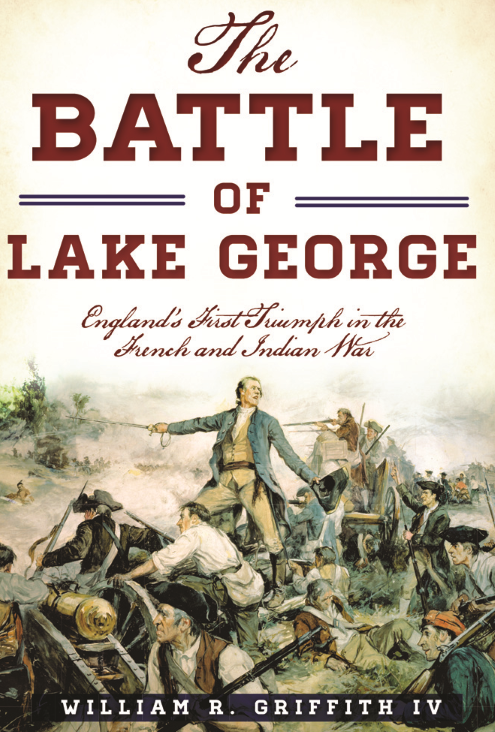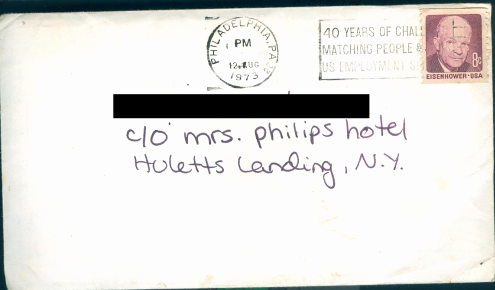
Entering Huletts Landing in the winter. Circa 1950’s.
President Taft’s Visit to Fort Ticonderoga focus of Fort Fever Series Program January 8th

President Taft speaks at Fort Ticonderoga during his visit on July 6, 1909.
Fort Ticonderoga’s “Fort Fever Series” begins on Sunday, January 8th, at 2 p.m. with “President Taft Comes to Ticonderoga,” presented by Director of Education, Rich Strum. Tickets are $10 per person and can be purchased at the door; Fort Ticonderoga Members are admitted free of cost. The program will take place at the Mars Education Center.
“William Howard Taft is the only sitting President of the United States to visit Fort Ticonderoga. Taft’s visit came early in his term, July 6, 1909, as part of the week-long Champlain Tercentenary Celebrations throughout the Champlain Valley,” said Rich Strum Fort Ticonderoga Director of Education. “The early restoration work at Fort Ticonderoga, undertaken by museum founders Stephen and Sarah Pell, was underway, and the President was given a tour of the work by Sarah Pell. Thousands attended the day-long event on the Ticonderoga peninsula. Learn about the advance planning, the scope of the celebration, and the details of Taft’s visit.”Rich Strum is the Director of Education at Fort Ticonderoga, serving as the Project Director for the Fort Ticonderoga Teacher Institute. He is managing Editor of The Bulletin of the Fort Ticonderoga Museum and the North Country Coordinator for New York State History Day.
The “Fort Fever Series” is just one of several programs taking place at Fort Ticonderoga this winter and early spring. Clothing and Accoutrement Workshops are offered March 11 & 12 and April 8 & 9. Fort Ticonderoga presents living history events January 21st (1757 Battle on Snowshoes), February 18th (1775 British Garrison at Ticonderoga), and March 25th (Four Divisions formed at Fort Carillon; Rigaud’s Attack of Fort William Henry). The Sixth Annual Garden & Landscape Symposium will be held on April 8th. You can learn more about these programs by visiting www.fortticonderoga.org. Some programs require advanced registration.
Top News Story of Huletts: 2016

Washington County highway department workers placing the new deck on the 6B bridge in Huletts Landing during June 2016. (Click image to see full-scale.)
Since I’ve been writing here on the Huletts Current, I’ve gotten in the habit of recapping at the end of the year what I consider to be the top news story of Huletts Landing from the past year. This is sometimes obvious, sometimes it is not. A lot happened this past year but the story that stood out to me, and was obvious to all in the Landing, was the county replacing the entire 6B bridge.
This work started in the Spring, continued into the Summer and was not finally completed until the Fall. The old bridge was entirely removed, the abutments were re-poured and a new deck and railings were added. The construction even impacted the water line to the golf course for a few weeks.
So for 2016, I’ve selected the rebuilding of the Washington County 6B bridge, as the: Top News Story of Huletts for 2016.
(Click images to see larger view.)
So for me, 2016 will ultimately be remembered as the year that the infrastructure in the center of the Landing was vastly improved even if it meant some minor inconveniences getting around. It took some time but hopefully it will last!
Now on to 2017!
Now for Some History: 1919
The NY State Archives has an image in their collection of William C. Noble, fire observer, sitting in the doorway of a wooden shack used for observing the outbreak of forest fires on Black Mountain in 1919. It can be enlarged to see full-scale.
Famous Supreme Court Case Has Local Connection
One of the most famous United States Supreme Court cases, Engel v. Vitale, 370 U.S. 421 (1962) (sometimes known as the school prayer case) has a significant local connection. William J. Vitale, Jr. was the School Board President of the school district that was involved in the case. Mr. Vitale was a summer resident of Huletts Landing for many years.
The case is still considered one of the top Supreme Court cases of all time. In an effort to learn more the case, I asked Mr. Vitale’s daughter, Lora Vitale Johnson, a few questions to learn more about her memories of this famous case.
To begin, can you share a little bit about your father’s involvement in this famous case?
In the not too distant past, when I was a twelve year old student in a Long Island school district named Herricks, the New York State Board of Regents proposed a prayer to be said at the opening of school in the mornings (along with the Pledge of Allegiance). It was non-denominational, and there was no mandate to add it to the morning opening, but was left to each individual school district to decide whether to include it or not.
At the time, William J. Vitale, Jr. was president of the board of education in the Herricks public school district. He presented the Regent’s Prayer to the board for a vote, and the board voted in favor of the recitation of the prayer daily in the schools (the president abstained).
While the prayer was non-denominational, and no student was compelled to recite it, it did refer to “God”:
God, we acknowledge our dependence upon thee,
Our parents, our teachers and our country
Did he attend the Supreme Court oral arguments?
The mention of “God” did not align with the atheistic viewpoint, and so, as Mr. Engel held that viewpoint, he felt, and rightly so, that the use of this prayer in the public schools was a violation of the separation of church and state, which was not the popular viewpoint.
Separation of Church and State, a constitutional amendment, became an issue for the times, and though other cases came up throughout the country, Engel vs. Vitale was an early bell weather case and was, of course, of national importance.
One might assume that my father (Vitale) was being sued; this was not the case. Because he was president of the Board of Education at the time, his name actually represented the school board as a whole. He did not try the case, although he was an attorney. He did attend some of the Supreme Court hearings.
What was the fallout locally after the decision was rendered?
The case became so important nationally, that CBS News produced a nationally aired television program titled STORM OVER THE SUPREME COURT. My father was interviewed, along with the board’s lawyer, Bertram Daiker, and Mr. Engel. A number of supporters of the prayer, of differing Christian and Judaic* denominations were also featured.
Although my personal feelings on the prayer aligned with the Supreme Court (both then and now), I’d thought that it could have been replaced with a moment of silence, during which an individual could recite a prayer, mantra, or other form which would allow time to reflect daily on a personally spiritual concept or concepts aimed at providing a thought process which would provide each student with a strong moral foundation on which to base his or her daily and life decisions.
It is my belief that many today are led to overdevelop egocentrism, which might well turn out to be a negative influence.
*Wikipedia is in error; this was not a dispute between the Judaic and Christian members of the Herricks School District
Editor’s Notes: The case reached the Supreme Court in 1962 and in an opinion delivered by Justice Hugo Black, the Court ruled that government-written prayers were not to be recited in public schools and were a violation of the U.S. Constitution and the Establishment Clause of the first amendment.
“New Hyde Park” Memorial is a different school district in Queens. Herricks comprises a number of towns, including the Nassau County section of New Hyde Park, an area of Roslyn, Williston Park, and others. It is situated geographically between Garden City to the south, and Manhasset to the north.
Many thanks to Ms. Vitale Johnson for sharing her memories about this important part of American history.
Now for Some History: 1973
Recently a picture of an envelope was sent to me that had been addressed to an individual staying with Irene Philips. It was postmarked August 12, 1973 and was sent to the “Philips Hotel” in Huletts.
I have previously posted pictures of the Philips property because it brings back memories of an earlier Huletts.
While not a hotel as we think of one today, Mrs. Philips did rent to many who stayed on her property. (Click image to see full-scale.)
Link: Battle of Fort Ann Explained
Saturday Quote
“In a democracy, someone who fails to get elected to office can always console himself with the thought that there was something not quite fair about it.”
Thucydides, History of the Peloponnesian War
Eight Years Old

Well, here it is November 9th. We have a new President-elect Trump and one doozy of a national election is now over. So today it’s time for some “real” news. Today is the day I celebrate the “birthday” of the Huletts Current. It’s now been exactly eight years since my first post in 2008. It’s been slow over the last few weeks but the site just went over 116,000 hits starting from January 1st, which has surpassed any previous year’s total.
I love hearing from everyone with story ideas, news and community “goings-on.” I enjoy learning from you and sharing your thoughts and pictures about Huletts. It’s a unique place, and I am thankful for all those who have made the site so successful.
As is my custom, here are the most read posts from the past year.
1.) Fire on Nobles Island Extinguished
2.) Pictures from the 2015 Huletts Christmas Party
3.) House on Mountain Burns Overnight
4.) Bridge Dedication in Memory of Maynard Rushia Well Attended
5.) County Route 6B Bridge Update
6.) Pictures from the 2015 Dresden Christmas Party
7.) Crosses Placed at Route 22 Fatal Crash
8.) Pictures from the HLVFC Annual “Open House”
9.) AED’s Arrive – Goal Achieved
10.) Work Finished to Prevent Post Office Parking Flooding
So thanks again for reading and now onto year nine!!
Bits of Everything
Former Board Member Rejected by Voters Appointed to Whitehall School Board
How a Rembrandt Ended Up in Glens Falls
From North Country Public Radio
Painters Headed to Ticonderoga
New Book: The Battle of Lake George

The Battle of Lake George: England’s First Triump in the French and Indian War by William R. Griffith IV was released this past week.
This is a great new release that sounds very intriguing.
In the early morning of September 8, 1755, a force of French Regulars, Canadians and Indians crouched unseen in a ravine south of Lake George. Under the command of French general Jean-Armand, Baron de Dieskau, the men ambushed the approaching British forces, sparking a bloody conflict for control of the lake and its access to New York’s interior. Against all odds, British commander William Johnson rallied his men through the barrage of enemy fire to send the French retreating north to Ticonderoga. The stage was set for one of the most contested regions throughout the rest of the conflict. Historian William Griffith recounts the thrilling history behind the first major British battlefield victory of the French and Indian War.
ISBN: 9781467119757
$21.99 | 144 pp.| paperback
Available: September 5, 2016
Now for Some History: July 1922

This postcard from July 20, 1922, depicting Huletts Landing, was mailed from Silver Bay NY.
Sometimes the most interesting part of an old postcard is what was written on it. Many thanks to Russ Considine for providing this glimpse into the summer of 1922. Here is what was written on the back:
“Have come to Silver Bay Y.M.C.A Conference and I never dreamed it was so nice. I am having a fine time. Hope to see you when I get back. Was so busy before I went away. – Amanda”
Addressed to:
Miss Leslie S Lifie
723 McKnight Street
Reading, PA
Postmarked: July 20, 1922 Silver Bay NY
“I never dreamed it was so nice,” were the words that I think we would still agree with today! (Click images to see full-scale.)
Bits of Everything
Happy July 4th






